JB TAK FODEGA NHI .... TB TK CHODEGA NHI .... (MAANG)
DPL16 Partition A Set Into Two Subsets With Minimum Absolute Sum Difference 🔥
We are given an array ‘ARR’ with N positive integers. We need to partition the array into two subsets
such that the absolute difference of the sum of elements of the subsets is minimum.
We need to return only the minimum absolute difference of the sum of elements of the two partitions.

Again This question is a slight modification of the problem discussed in LDP14. We need to
partition the array into two subsets such that the absolute difference of the sum of elements of the
subsets is minimum.
Algorithm / Intuition
Before discussing the approach for this question, it is important to understand what we did in the
previous question of the DPL14. There we found whether or not a subset exists in an array with
a given target sum. We used a dp array to get to our answer.
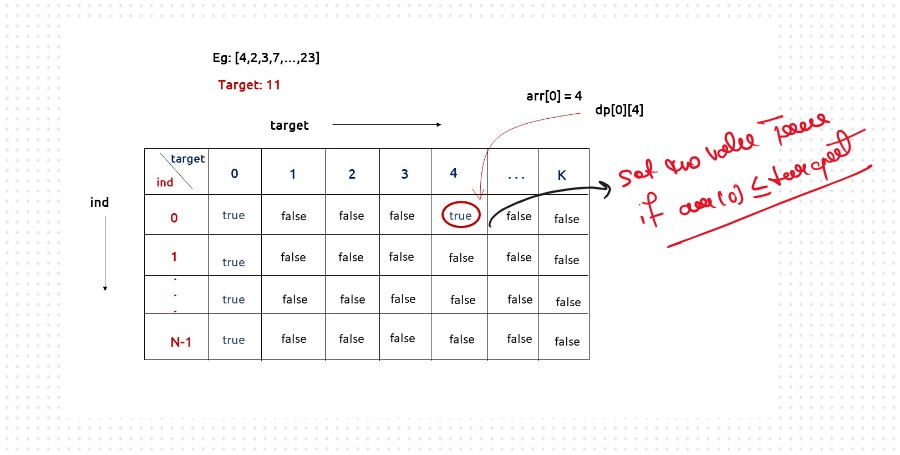
what a Subsequence/Subset?
A subset/subsequence is a contiguous or non-contiguous part of an array, where elements appear in the
same order as the original array.
For example, for the array: [2,3,1] , the subsequences will be [{2},{3},{1},{2,3},{2,1},{3,1},{2,3,1}]
but {3,2} is not a subsequence because its elements are not in the same order as the original
array.
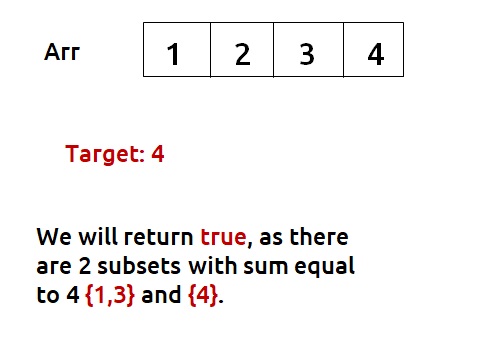 We used to return dp[n-1][k] as our answer. One interesting thing that is happening is that for
calculating our answer for dp[n-1][k], we are also solving multiple sub-problems and at the same time
storing them as well. We will use this property to solve the question
In this question, we need to partition the array into two subsets( say with sum S1 and S2) and we
need to return the minimized absolute difference of S1 and S2. But do we need two variables for it?
The answer is No. We can use a variable totSum, which stores the sum of all elements of the input
array, and then we can simply say S2 = totSum – S1. Therefore we only need one variable S1.
Now, what values can S1 take? Well, it can go anywhere from 0 (no elements in S1) to totSum( all
elements in S1). If we observe the last row of the dp array which we had discussed above, it gives us
the targets for which there exists a subset. We will set its column value to totSum, to find the
answer from 0(smaller limit of S1) to totSum (the larger limit of S1).
Our work is very simple, using the last row of the dp array, we will first find which all S1 values
are valid. Using the valid S1 values, we will find S2 (totSum – S1). From this S1 and S2, we will find
their absolute difference. We will return the minimum value of this absolute difference as our answer.
We used to return dp[n-1][k] as our answer. One interesting thing that is happening is that for
calculating our answer for dp[n-1][k], we are also solving multiple sub-problems and at the same time
storing them as well. We will use this property to solve the question
In this question, we need to partition the array into two subsets( say with sum S1 and S2) and we
need to return the minimized absolute difference of S1 and S2. But do we need two variables for it?
The answer is No. We can use a variable totSum, which stores the sum of all elements of the input
array, and then we can simply say S2 = totSum – S1. Therefore we only need one variable S1.
Now, what values can S1 take? Well, it can go anywhere from 0 (no elements in S1) to totSum( all
elements in S1). If we observe the last row of the dp array which we had discussed above, it gives us
the targets for which there exists a subset. We will set its column value to totSum, to find the
answer from 0(smaller limit of S1) to totSum (the larger limit of S1).
Our work is very simple, using the last row of the dp array, we will first find which all S1 values
are valid. Using the valid S1 values, we will find S2 (totSum – S1). From this S1 and S2, we will find
their absolute difference. We will return the minimum value of this absolute difference as our answer.
Now remaining Entire 👇 Process will Be Same As Like in DPL14
Recursice Approch
Steps to form the Recursive Solution
Step 1: Express the problem in terms of indexes.
The array will have an index but there is one more parameter “target”. We are given the initial
problem to find whether there exists in the whole array a subsequence whose sum is equal to the
target.
So, we can say that initially, we need to fun(n-1, target) which means that we need to find
whether there exists a subsequence in the array from index 0 to n-1, whose sum is equal to the
target. Similarly, we can generalize it for any index ind as follows:
 Our Base
If target == 0, it means that we have already found the subsequence from the previous steps, so we
can return true.
If ind==0, it means we are at the first element, so we need to return arr[ind]==target. If the
element is equal to the target we return true else false.
Our Base
If target == 0, it means that we have already found the subsequence from the previous steps, so we
can return true.
If ind==0, it means we are at the first element, so we need to return arr[ind]==target. If the
element is equal to the target we return true else false.
The Recursive Function is
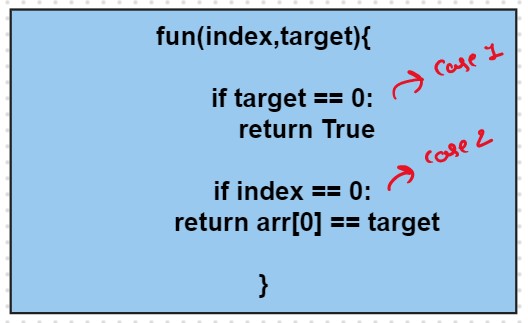 Step 2: Try out all possible choices at a given index.
Step 2: Try out all possible choices at a given index.
We need to generate all the subsequences. We will use the pick/non-pick technique as discussed in,
That we All Ready Learn in the Recursion Series.
We have two choices:
Exclude the current element in the subsequence: We first try to find a subsequence without
considering the current index element. For this, we will make a recursive call to f(ind-1,target).
Include the current element in the subsequence: We will try to find a subsequence by
considering the current index as element as part of subsequence. As we have included arr[ind], the
updated target which we need to find in the rest if the array will be target – arr[ind]. Therefore, we
will call f(ind-1,target-arr[ind]).
Note: We will consider the current element in the subsequence only when the current element is less
or equal to the target.
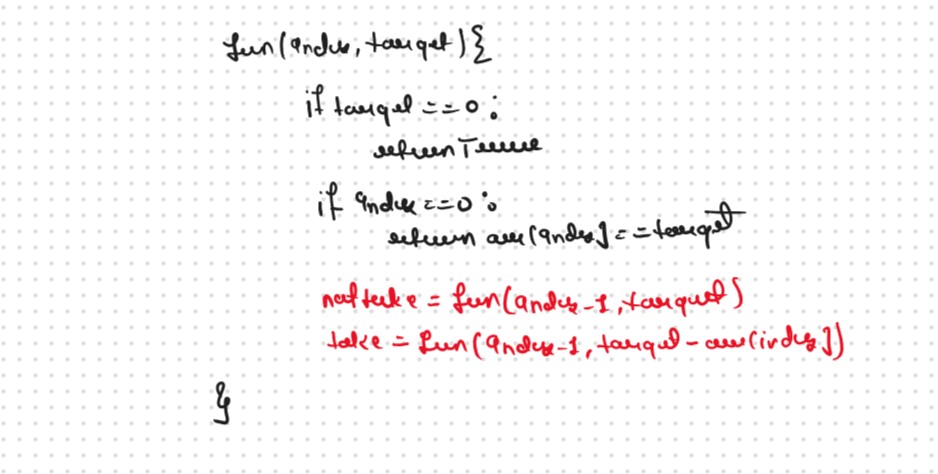
Step 3: Return (taken || notTaken)
As we are looking for only one subset, if any of the one among taken or not taken returns true, we
can return true from our function. Therefore, we return ‘or(||)’ of both of them.
The final pseudocode after steps 1, 2, and 3:
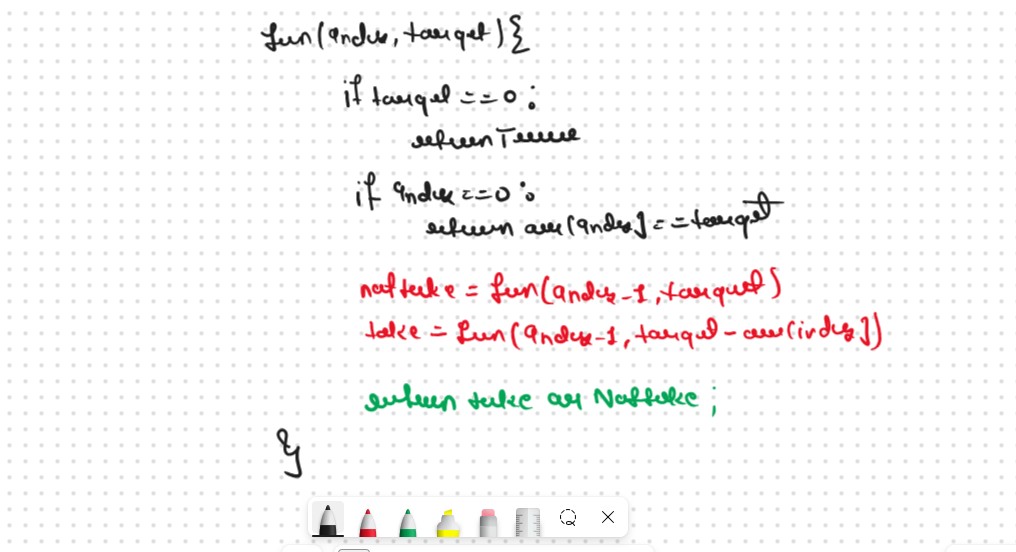 Recursion Base Conditions
If target == 0, it means that we have already found the subsequence from the previous steps, so we
can return true.
If ind==0, it means we are at the first element, so we need to return arr[ind]==target. If the
element is equal to the target we return true else false.
Recursion Tree
Recursion Base Conditions
If target == 0, it means that we have already found the subsequence from the previous steps, so we
can return true.
If ind==0, it means we are at the first element, so we need to return arr[ind]==target. If the
element is equal to the target we return true else false.
Recursion Tree
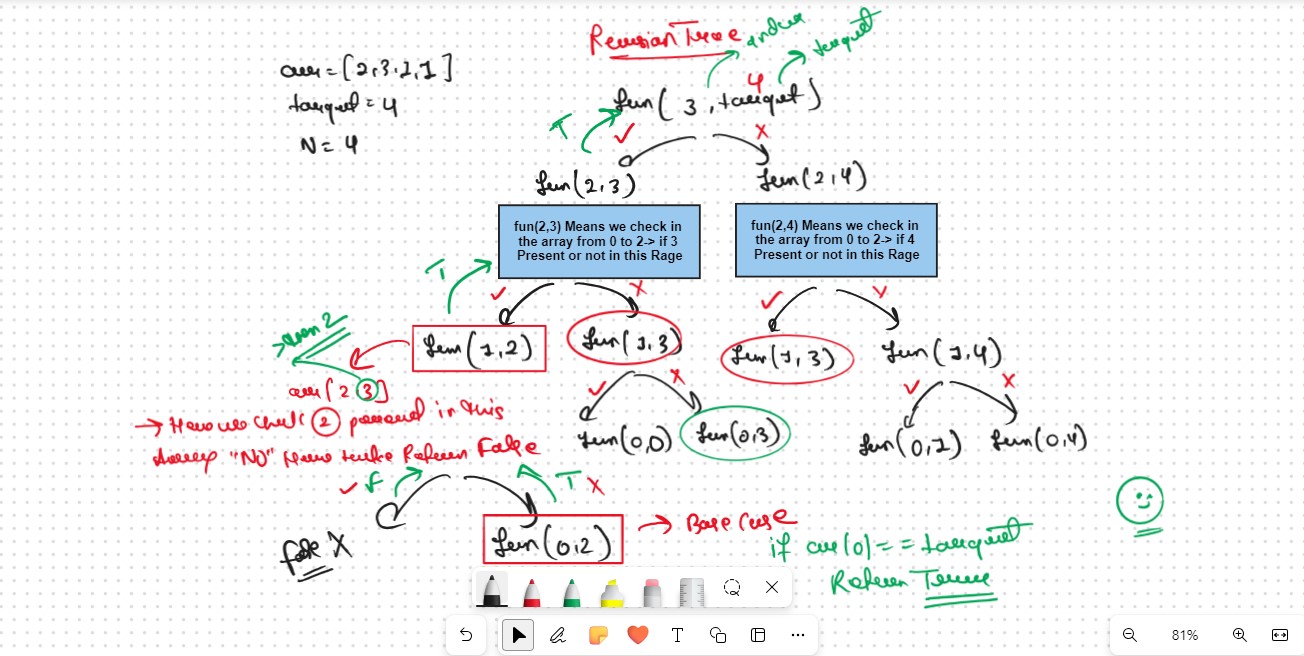
Recursion Java Code
Sb Mai He Kru ...
Khud Bhi Kr le Khuch ..... Nalayk
Time & Space Complexity
Time Complexity: O(2^N)
Reason: Exponential Time we find out the all the Possible Path
Space Complexity: O(N)
Reason: We are using a recursion stack space(O(N))
Memoization Approch
If we observe in the recursion tree, we will observe a many number of overlapping subproblems.
Therefore the recursive solution can be memoized for to reduce the time complexity.
 Steps to convert Recursive code to memoization solution:
Create a dp array of size [n][totSum+1]. The size of the input array is ‘n’, so the index will
always lie between ‘0’ and ‘n-1’. The target can take any value between ‘0’ and ‘totSum’. Therefore we
take the dp array as dp[n][totSum+1]
We initialize the dp array to -1.
Whenever we want to find the answer of particular parameters (say f(ind,target)), we first check
whether the answer is already calculated using the dp array(i.e dp[ind][target]!= -1 ). If yes, simply
return the value from the dp array.
If not, then we are finding the answer for the given value for the first time, we will use the
recursive relation as usual but before returning from the function, we will set dp[ind][target] to the
solution we get.
When we get the dp array, we will use its last row to find the absolute minimum difference of two
partitions.
Steps to convert Recursive code to memoization solution:
Create a dp array of size [n][totSum+1]. The size of the input array is ‘n’, so the index will
always lie between ‘0’ and ‘n-1’. The target can take any value between ‘0’ and ‘totSum’. Therefore we
take the dp array as dp[n][totSum+1]
We initialize the dp array to -1.
Whenever we want to find the answer of particular parameters (say f(ind,target)), we first check
whether the answer is already calculated using the dp array(i.e dp[ind][target]!= -1 ). If yes, simply
return the value from the dp array.
If not, then we are finding the answer for the given value for the first time, we will use the
recursive relation as usual but before returning from the function, we will set dp[ind][target] to the
solution we get.
When we get the dp array, we will use its last row to find the absolute minimum difference of two
partitions.
Memoization Java Code
Sb Mai He Kru ...
Khud Bhi Kr le Khuch ..... Nalayk
Time & Space Complexity
Time Complexity: O(N*totSum) +O(N) +O(N)
Reason: There are two nested loops that account for O(N*totSum), at starting we are running a for loop
to calculate totSum and at last a for loop to traverse the last row.
Space Complexity: O(N*totSum) + O(N)
Reason: We are using an external array of size ‘N * totSum’ and a stack space of O(N).
Tabulation Approch
Tabulation is a
‘bottom-up’ approach where we start from the base case and reach the final answer
that we want and Memoization is the
Top-down Approch.
In Tabulation Approch We Just Creat a DP Array Same as Memoization and Simply Convert the Recurance
Relation into the form of the Looping
Steps to convert Recursive Solution to Tabulation one.
To convert the memoization approach to a tabulation one, create a dp array with the same size as
done in memoization. We can set its type as bool and initialize it as false.
 First, we need to initialize the base conditions of the recursive solution.
First, we need to initialize the base conditions of the recursive solution.
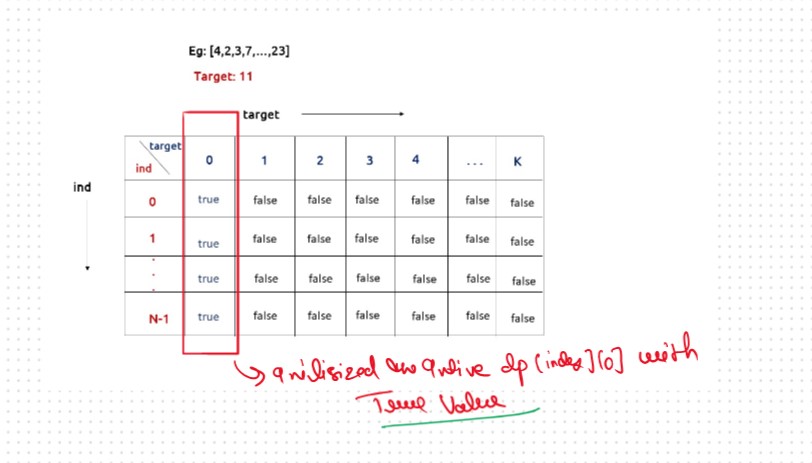 If target == 0, ind can take any value from 0 to n-1, therefore we need to set the value of the
first column as true.
If target == 0, ind can take any value from 0 to n-1, therefore we need to set the value of the
first column as true.
 The first row dp[0][] indicates that only the first element of the array is considered, therefore for
the target value equal to arr[0], only cell with that target will be true, so explicitly set
dp[0][arr[0]] =true, (dp[0][arr[0]] means that we are considering the first element of the array with
the target equal to the first element itself). Please note that it can happen that arr[0]>target, so
we first check it: if(arr[0]<=target) then set dp[0][arr[0]]=true.
After that , we will set our nested for loops to traverse the dp array and following the logic
discussed in the recursive approach, we will set the value of each cell. Instead of recursive calls,
we will use the dp array itself.
When we get the dp array, we will use its last row to find the absolute minimum difference between two
partitions.
The first row dp[0][] indicates that only the first element of the array is considered, therefore for
the target value equal to arr[0], only cell with that target will be true, so explicitly set
dp[0][arr[0]] =true, (dp[0][arr[0]] means that we are considering the first element of the array with
the target equal to the first element itself). Please note that it can happen that arr[0]>target, so
we first check it: if(arr[0]<=target) then set dp[0][arr[0]]=true.
After that , we will set our nested for loops to traverse the dp array and following the logic
discussed in the recursive approach, we will set the value of each cell. Instead of recursive calls,
we will use the dp array itself.
When we get the dp array, we will use its last row to find the absolute minimum difference between two
partitions.
Tabulation Java Code
Sb Mai He Kru ...
Khud Bhi Kr le Khuch ..... Nalayk
Time & Space Complexity
Time Complexity: O(N*totSum) +O(N) +O(N)
Reason: There are two nested loops that account for O(N*totSum), at starting we are running a for loop
to calculate totSum, and at last a for loop to traverse the last row.
Space Complexity: O(N*totSum)
Reason: We are using an external array of size ‘N * totSum’. Stack Space is eliminated.
Space Optimization
If we closelly Observed if any Tabulation Approch we used the Some Limited Stuff like:
dp[ind][target] = dp[ind-1][target] || dp[ind-1][target-arr[ind]] for the finding the our ans
then definetly here Spaced Optimization is Possible in that types of Problems. Always
Remember
Golden Rule
If we required only Prev row and Prev Collom then definetly we can Space Optimized
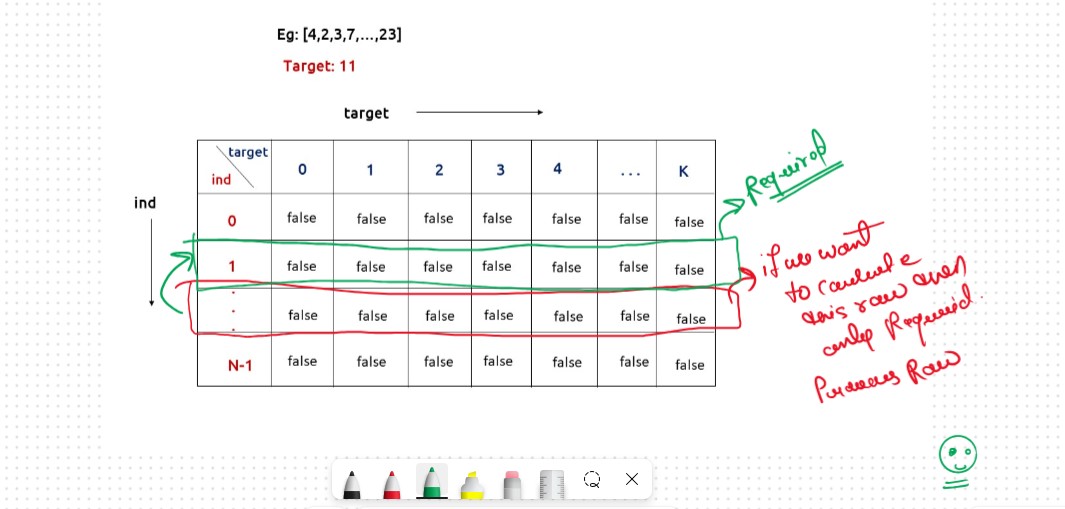
We see that we only need the previous row and column, in order to calculate curr[i]. Therefore we
can space optimize it.
Initially, we can take a dummy row ( say prev) and initialize it as False.
Now the current row(say temp) only needs the previous row value and the current row’s value in
order to curr[i].
Whenever we create a new row ( say cur), we need to explicitly set its first element is true
according to our base condition.
At last Min will give us the required answer.
SpaceOptmized Python Code
SpaceOptmized Java Code
Sb Mai He Kru ...
Khud Bhi Kr le Khuch ..... Nalayk
Time & Space Complexity
Time Complexity: O(N*totSum) +O(N) +O(N)
Reason: There are two nested loops that account for O(N*totSum), at starting we are running a for loop
to calculate totSum and at last a for loop to traverse the last row.
Space Complexity: O(totSum)
Reason: We are using an external array of size ‘totSum+1’ to store only one row.
Interview Docs File "All the Best" Team @DSAwithPrinceSingh








.png)
.png)

.png)
.png)



.png)
.png)

.png)
.png)














